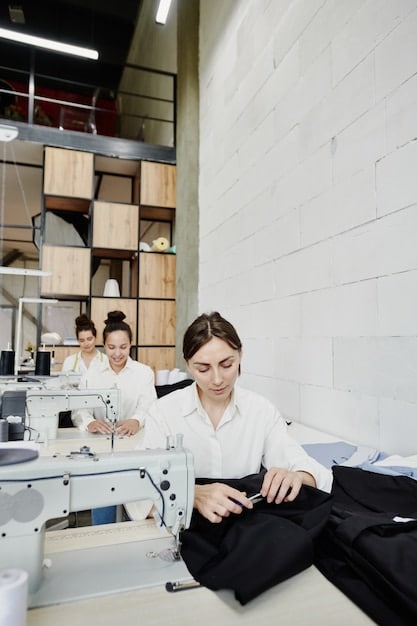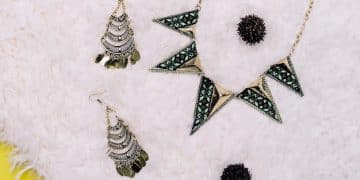Sustainable Summer Style: Eco-Friendly Fashion 2025

Achieving a sustainable summer style in 2025 involves embracing eco-conscious choices, from innovative fabrics and ethical production to mindful consumption, transforming personal wardrobes into powerful statements for environmental responsibility and social equity.
As the climate conversation intensifies, the fashion industry faces an unprecedented call for change. Consumers are increasingly seeking alternatives to fast fashion’s environmental toll. This article delves into how a sustainable summer style for 2025 goes beyond fleeting trends, focusing on eco-friendly fashion choices that resonate with an evolving consciousness.
The Urgency of Eco-Conscious Fashion in 2025
The fashion industry’s environmental footprint is a pressing concern, contributing significantly to global pollution and resource depletion. From water-intensive cotton farming to synthetic microplastic pollution, the impact is undeniable.
As we approach 2025, the conversation has shifted from awareness to urgent action. Consumers are not just asking “why” but “how” they can contribute to a more sustainable future through their purchasing habits. This drives brands to innovate and adapt, embracing circularity and ethical production.
The Environmental Impact of Traditional Fashion: A Closer Look
Understanding the scale of the problem is the first step towards embracing a sustainable wardrobe. Traditional fashion often relies on linear production models: extract, produce, consume, dispose.
- Water Consumption: Producing a single cotton t-shirt can require thousands of liters of water.
- Chemical Pollution: Dyes and finishes release toxic chemicals into waterways.
- Waste Generation: Over 85% of textiles end up in landfills annually, contributing to methane emissions.
- Carbon Emissions: The entire supply chain, from fiber production to transport, is carbon-intensive.
These issues highlight why a mere trend towards sustainability is insufficient; a systemic transformation is needed. Brands and consumers alike share the responsibility to innovate and adopt more responsible practices.
The urgency stems from scientific consensus and visible environmental degradation. Consumers, particularly younger generations, are driving demand for transparency and tangible environmental improvements. This pressure is accelerating the adoption of sustainable practices, moving them from niche to mainstream considerations within the industry.
Ultimately, the goal is to shift towards a regenerative system where fashion not only minimizes harm but actively contributes to environmental and social well-being. This vision informs the sustainable summer style choices we discuss, emphasizing longevity, resource efficiency, and ethical considerations.
Innovative Fabrics and Materials for a Green Summer Wardrobe
The bedrock of a sustainable summer style lies in the materials chosen. Innovations in textile science are rapidly expanding the options available, offering environmentally friendlier alternatives to conventional fabrics.
Beyond organic cotton and linen, which have long been staples, new materials are emerging from unexpected sources, providing exciting possibilities for both performance and aesthetics. These advancements aim to reduce water usage, chemical dependency, and waste throughout the production cycle.
Discovering Cutting-Edge Sustainable Textiles
The landscape of sustainable fabrics is dynamic and diverse, reflecting a commitment to innovation and responsible sourcing. Each material offers unique benefits, addressing different environmental challenges.
- Tencel Lyocell: Derived from sustainably sourced wood pulp, Tencel is produced in a “closed-loop” system that recycles water and solvents. It’s known for its softness, breathability, and moisture-wicking properties, making it ideal for summer.
- Hemp: Requiring minimal water and no pesticides to grow, hemp is an incredibly durable and versatile fiber. It softens with wear, making it a great choice for casual summer attire.
- Recycled Materials (RPET, Recycled Cotton): Repurposing plastic bottles (RPET) or textile waste (recycled cotton) into new garments significantly reduces landfill waste and the demand for virgin resources. Advances in recycling technology are making these materials increasingly comfortable and stylish.
- Piñatex: An innovative leather alternative made from pineapple leaf fibers. It offers a naturally durable, water-resistant, and versatile material for accessories and footwear, showcasing bio-based alternatives to animal products.
- Organic Linen: A classic summer fabric, organic linen is sustainable due to its low water and pesticide requirements. Its natural breathability and airy feel make it perfect for hot weather.
These materials represent a shift towards more thoughtful production, considering the entire lifecycle of a garment. They often come with certifications that assure consumers of their environmental claims.
For 2025, expect to see an even wider adoption of these materials, moving beyond niche eco-brands into more mainstream collections. This increased availability will make sustainable choices more accessible to a broader audience.
Consumers are encouraged to seek out fabric blends that combine the best properties of these sustainable options, such as organic cotton and Tencel, for enhanced comfort and durability. This thoughtful approach to material selection is a cornerstone of building a truly sustainable summer wardrobe.
Ethical Production and Fair Labor Practices
Sustainability in fashion extends beyond environmental factors to include the human element. Ethical production and fair labor practices are crucial pillars of a truly responsible supply chain, ensuring that the people who make our clothes are treated with dignity and fairness.
The spotlight on factory conditions and wages has intensified, driven by growing consumer awareness and a desire for transparency. Brands are increasingly held accountable for the entire lifecycle of their products, from farm to finished garment.
Ensuring People and Planet Thrive: Key Principles
Fair labor practices encompass a range of principles designed to protect workers’ rights and promote safe working environments. These principles are fundamental to a holistic approach to sustainable fashion.
- Fair Wages: Workers should receive a living wage that covers their basic needs and allows for discretionary income.
- Safe Working Conditions: Factories must adhere to strict health and safety standards, providing clean, well-lit environments free from hazards.
- No Child Labor or Forced Labor: Strict policies against employing minors and any form of forced or indentured labor are paramount.
- Freedom of Association: Workers should have the right to join unions and engage in collective bargaining without fear of reprisal.
- Reasonable Working Hours: Adherence to legal limits on working hours and provisions for adequate breaks and rest days.
Brands demonstrating a commitment to these practices often seek certifications from organizations like Fair Trade, SA8000, or the Global Organic Textile Standard (GOTS), which verify adherence to social and environmental standards.

The challenge for many brands lies in tracing their supply chains effectively, especially in complex global networks. However, advancements in blockchain technology and supply chain transparency tools are making this easier, allowing consumers to verify claims. By supporting brands that prioritize ethical production, consumers contribute to a more equitable and just fashion industry.
This commitment to ethical sourcing is not just about avoiding harm; it’s about actively contributing to the well-being of communities and individuals involved in clothing production. It’s an integral part of what makes a summer style truly sustainable and responsible.
The Circular Economy: Repair, Reuse, Recycle for Summer Wear
Moving beyond linear consumption, the circular economy offers a transformative model for fashion, emphasizing longevity, resource efficiency, and waste reduction. For a sustainable summer style, this means embracing practices that keep garments in circulation for as long as possible.
Instead of buying new, consider giving existing garments a new lease on life. This approach significantly reduces the demand for new production and minimizes textile waste, aligning perfectly with summer’s light and carefree spirit that values resourcefulness.
Embracing Longevity and Resourcefulness
The principles of the circular economy are straightforward but impactful. They challenge the notion that clothing is disposable and encourage a more mindful relationship with our wardrobes.
- Repair and Mend: Small tears or loose buttons shouldn’t mean discarding a garment. Learning basic mending skills or utilizing local tailors extends the life of summer dresses, shorts, and tops.
- Upcycling and Customization: Transform old or ill-fitting summer pieces into something new. A long skirt can become a top, or a worn-out t-shirt can be tie-dyed or embroidered for a fresh look.
- Second-Hand and Vintage Shopping: Explore thrift stores, consignment shops, and online platforms for pre-loved summer treasures. This is arguably one of the most impactful ways to reduce fashion’s environmental footprint.
- Renting and Swapping: For special occasions or seasonal trends, consider renting formal wear or participating in clothing swaps with friends. This offers variety without ownership.
- Proper Care: Washing clothes less frequently, using cold water, and air-drying them not only saves energy but also preserves the life and color of the fabric.
These practices empower consumers to participate actively in reducing waste and promoting resource efficiency. They also foster creativity and personal expression, as unique, one-of-a-kind pieces often emerge from these efforts.
Many brands are also launching take-back programs and repair services, recognizing the value in their products’ extended life. Others are designing garments from the outset with circularity in mind, using materials that are easily recyclable or compostable at the end of their useful life. This systemic shift is vital for a truly sustainable future.
By engaging with the circular economy, our summer style becomes less about transient trends and more about timeless pieces that are cherished, cared for, and given multiple lives.
Mindful Consumption: Less Is More for a Sustainable Summer
At the heart of a truly sustainable summer style is the principle of mindful consumption. This concept encourages us to buy less, choose better, and appreciate the value of what we already own. It’s a direct counter-narrative to the fast-fashion cycle of constant newness and disposability.
For 2025, mindful consumption means a deliberate shift in purchasing habits, moving away from impulse buys towards intentional, well-researched decisions that align with personal values and environmental impact.
Curating a Conscious Summer Wardrobe
Building a mindful wardrobe involves thought and planning, leading to a collection of versatile, cherished pieces rather than an overflowing closet of forgotten items. It’s about quality over quantity.
- Identify Your Style: Understand what truly suits your body and lifestyle. This reduces the likelihood of buying items that don’t get worn.
- Invest in Versatile Staples: Focus on timeless pieces that can be mixed and matched creating multiple outfits. A classic linen shirt, well-fitting shorts, or a versatile sundress can be styled in numerous ways.
- Research Brands: Before purchasing, investigate a brand’s sustainability claims. Look for certifications, transparency in their supply chain, and genuine commitment to ethical practices.
- Avoid Impulse Buys: Take time to consider if an item is truly needed and if it aligns with your conscious values. Ask yourself: “Will I wear this at least 30 times?”
- Embrace “No-Buy” Challenges: Participate in personal or community “no-buy” challenges for a month or a season. This fosters creativity with existing clothes and highlights consumption patterns.
Mindful consumption also encompasses caring for your clothes properly to extend their lifespan, treating each item as an investment rather than a temporary trend. This attention to detail reduces the need for frequent replacements.

For summer, this translates to a curated collection of comfortable, breathable, and adaptable pieces. Think multi-functional items that can transition from beach to evening, reducing the overall volume of clothes needed. This approach celebrates personal style with a clear conscience, proving that less often is indeed more.
By prioritizing mindful consumption, we empower ourselves to be agents of change, making choices that benefit both our personal well-being and the planet. It is an active decision to buy better and wear longer.
Future Trends and Innovations in Sustainable Summer Fashion
The pace of innovation in sustainable fashion is accelerating, promising even more exciting and impactful developments for the future of summer style. Researchers, designers, and entrepreneurs are pushing boundaries, exploring new ways to create beautiful clothing with minimal environmental impact.
In 2025 and beyond, we can anticipate a continued blurring of lines between technology, science, and fashion, leading to revolutionary materials and production methods. These trends point towards a future where sustainability is not a niche but an integrated part of design and manufacturing.
What to Expect in Eco-Fashion’s Horizon
Several key areas are poised for significant growth and influence in shaping the sustainable summer fashion landscape:
- Biodegradable and Compostable Materials: Beyond just natural fibers, the focus will intensify on materials that can fully decompose at the end of their life, returning nutrients to the earth. Examples include mushroom-based “leather” (Mylo) and algae-derived fabrics.
- Lab-Grown and Bio-Synthesized Textiles: Advances in biotechnology may lead to materials grown in labs, such as “spider silk” without the spider (made from yeast), or bacteria-dyed fabrics that reduce water and chemical use.
- On-Demand and Hyper-Local Production: To minimize waste and transportation emissions, more brands may adopt on-demand manufacturing and localized supply chains, producing garments only when ordered and closer to the consumer.
- Digital Fashion and Virtual Showrooms: Digital fashion, designed for virtual spaces, reduces physical production entirely. Virtual showrooms and try-on apps also decrease the need for physical samples and returns, lessening carbon footprints.
- Advanced Recycling Technologies: New methods for textile-to-textile recycling will become more efficient and widespread, allowing a broader range of fabrics to be effectively recycled back into high-quality new fibers.
These innovations highlight a movement towards a truly circular and low-impact fashion system. They challenge conventional manufacturing processes and offer tantalizing glimpses into a future where fashion can be inherently regenerative.
For summer 2025, while some of these technologies may still be in early adoption stages, their influence on design and material development will grow. Consumers will likely see more products incorporating these cutting-edge elements, making sustainable choices even more appealing and technologically advanced.
The future of sustainable summer style is bright, promising a fusion of aesthetic appeal with profound environmental responsibility. It’s a testament to human ingenuity in addressing critical global challenges through creative solutions.
Building Your Sustainable Summer Style in 2025: A Practical Guide
Translating sustainable fashion principles into a practical summer wardrobe doesn’t have to be overwhelming. It’s about taking small, deliberate steps that collectively lead to a significant impact. This guide offers actionable advice to help you curate a stylish, eco-conscious summer look for 2025.
The key is to integrate sustainability into your decision-making process, making it a natural extension of your personal style. It’s not about sacrificing aesthetics, but rather enhancing them with ethical and ecological awareness.
Actionable Steps for an Eco-Friendly Summer Wardrobe
Empower yourself with these practical tips to make sustainable fashion choices second nature:
- Start with What You Have: Before buying anything new, assess your current wardrobe. Identify versatile pieces, and consider how they can be styled creatively for summer. Declutter, but don’t just discard; donate, sell, or upcycle items you no longer need.
- Prioritize Natural and Recycled Fibers: When shopping, actively look for labels indicating materials like organic cotton, linen, hemp, Tencel, or recycled polyester. These are generally better choices for the environment and often feel great against the skin in summer.
- Support Transparent and Ethical Brands: Seek out brands that openly share their supply chain information, production processes, and commitment to fair labor. Certifications (e.g., GOTS, Fair Trade) can be helpful indicators.
- Embrace Second-Hand and Vintage Fashion: Explore local thrift stores, consignment shops, and online marketplaces. You can find unique, high-quality summer pieces at affordable prices, giving them a second life and reducing demand for new production.
- Care for Your Clothes Mindfully: Learn proper garment care. Wash in cold water, air dry when possible, and use gentle, biodegradable detergents. This extends the life of your clothes and reduces energy consumption.
- Choose Timeless Over Trendy: Invest in high-quality, classic summer styles that won’t go out of fashion quickly. Versatile colors and silhouettes ensure longevity and adaptability, allowing you to wear pieces season after season.
- Support Local and Artisan: Buy from local designers or artisans who often produce in smaller batches, use sustainable materials, and have transparent production methods. This supports local economies and reduces transportation footprints.
Remember that building a sustainable wardrobe is a journey, not a destination. Each conscious choice contributes to a more responsible and fashionable future. Don’t aim for perfection overnight; instead, focus on continuous improvement and learning.
By implementing these steps for your 2025 summer style, you not only elevate your personal aesthetic but also make a tangible positive impact on the planet and its people. Sustainable fashion is accessible, desirable, and increasingly the only way forward.
| Key Point | Brief Description |
|---|---|
| 🌱 Eco-Friendly Fabrics | Prioritize materials like organic cotton, linen, hemp, Tencel, and recycled options for reduced environmental impact. |
| 🔄 Circular Fashion | Embrace repair, reuse, second-hand shopping, and upcycling to extend garment life and minimize waste. |
| 💡 Mindful Consumption | Focus on quality over quantity, investing in versatile, timeless pieces and researching brand ethics before purchase. |
| 🌍 Ethical Production | Support brands committed to fair wages, safe working conditions, and transparency throughout their supply chains. |
Frequently Asked Questions About Sustainable Summer Style
▼
For a sustainable summer, prioritize natural fibers like organic cotton, linen, and hemp due to their breathability and lower environmental impact in cultivation. Tencel (Lyocell) is also an excellent option, known for its closed-loop production system that recycles water and solvents, making it highly eco-friendly.
▼
Look for brands that offer transparency about their supply chains and production processes. Certifications like GOTS (Global Organic Textile Standard), Fair Trade, or B Corp indicate adherence to environmental and social standards. Researching reviews and sustainability reports from the brand’s website can also provide valuable insights into their practices.
▼
Yes, second-hand shopping is highly sustainable. It significantly reduces the demand for new production, conserving resources like water and energy, and lowering carbon emissions associated with manufacturing and transport. It also minimizes textile waste ending up in landfills, keeping valuable materials in circulation longer while offering unique, affordable finds.
▼
Personal care and maintenance are crucial for sustainability by extending garment lifespan. Washing clothes less frequently, using cold water, and air-drying conserves energy and water. Mending minor damages like loose buttons or small tears prevents premature discarding. Proper care reduces the need for frequent replacements, lowering overall consumption.
▼
For 2025, expect to see more innovation in biodegradable materials like mushroom-based “leather” and algae-derived fabrics. Lab-grown textiles such as bio-synthesized silks are also emerging. The industry is moving towards on-demand production and advanced textile-to-textile recycling technologies to further close the loop on fashion waste.
Conclusion
Embracing a sustainable summer style in 2025 is more than a fleeting trend; it represents a fundamental shift towards more conscious and responsible fashion choices. By prioritizing innovative, eco-friendly fabrics, supporting ethical production, adopting circular economy principles, and practicing mindful consumption, individuals can make a tangible difference. The future of fashion lies in harmonizing aesthetic appeal with a deep commitment to environmental stewardship and social equity. Each thoughtful decision contributes to a wardrobe that not only looks good but also does good, paving the way for a more sustainable and stylish future.





